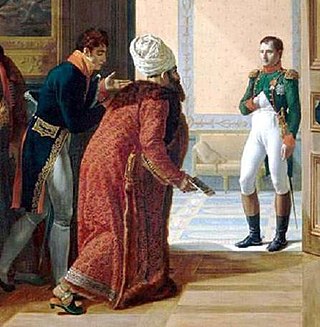Related Research Articles

Constantinople became the capital of the Roman Empire during the reign of Constantine the Great in 330. Following the collapse of the Western Roman Empire in the late 5th century, Constantinople remained the capital of the Eastern Roman Empire, the Latin Empire (1204–1261), and the Ottoman Empire (1453–1922). Following the Turkish War of Independence, the Turkish capital then moved to Ankara. Officially renamed Istanbul in 1930, the city is today the largest city in Europe, straddling the Bosporus strait and lying in both Europe and Asia, and the financial centre of Turkey.

The fall of Constantinople, also known as the conquest of Constantinople, was the capture of the capital of the Byzantine Empire by the Ottoman Empire. The city was captured on 29 May 1453 as part of the culmination of a 53-day siege which had begun on 6 April.

Anadoluhisarı, known historically as Güzelce Hisar is a medieval Ottoman fortress located in Istanbul, Turkey on the Anatolian (Asian) side of the Bosporus. The complex is the oldest surviving Turkish architectural structure built in Istanbul, and further gives its name to the neighborhood around it in the city's Beykoz district.

The Ottoman Empire used various flags and naval ensigns during its history. The crescent and star came into use in the second half of the 18th century. A buyruldu (decree) from 1793 required that the ships of the Ottoman Navy were to use a red flag with the star and crescent in white. In 1844, a version of this flag, with a five-pointed star, was officially adopted as the Ottoman national flag. The decision to adopt a national flag was part of the Tanzimat reforms which aimed to modernize the Ottoman state in line with the laws and norms of contemporary European states and institutions.

A dragoman was an interpreter, translator, and official guide between Turkish-, Arabic-, and Persian-speaking countries and polities of the Middle East and European embassies, consulates, vice-consulates and trading posts. A dragoman had to have a knowledge of Arabic, Persian, Turkish, and European languages.

Istanbul is the largest city in Turkey, straddling the Bosporus Strait, the boundary between Europe and Asia. It is considered the country's economic, cultural and historic capital. The city has a population of over 15 million residents, comprising 19% of the population of Turkey, and is the most populous city in Europe and the world's fifteenth-largest city.
Çandarlı Halil Pasha, known as the Younger, was a highly influential Ottoman grand vizier under the sultans Murad II and, for the first few years of his reign, Mehmed II. He was a member of the Çandarlı family, a highly influential political family in the Ottoman Empire. His grandfather and namesake, Çandarlı Kara Halil Hayreddin Pasha, also earlier served as grand vizier, under Murad I.

Ahmed Effendi, better known by his mahlasNedîm, was an Ottoman lyric poet of the Tulip Period. He achieved his greatest fame during the reign of Ahmed III. He was known for his slightly decadent, even licentious poetry often couched in the most staid of classical formats, but also for bringing the folk poetic forms of türkü and şarkı into the court.
The city of Istanbul has been known by a number of different names. The most notable names besides the modern Turkish name are Byzantium, Constantinople, and Stamboul. Different names are associated with different phases of its history, with different languages, and with different portions of it.

Neolithic artifacts, uncovered by archeologists at the beginning of the 21st century, indicate that Istanbul's historic peninsula was settled as far back as the 6th millennium BCE. That early settlement, important in the spread of the Neolithic Revolution from the Near East to Europe, lasted for almost a millennium before being inundated by rising water levels. The first human settlement on the Asian side, the Fikirtepe mound, is from the Copper Age period, with artifacts dating from 5500 to 3500 BCE. In the European side, near the point of the peninsula (Sarayburnu) there was a settlement during the early 1st millennium BCE. Modern authors have linked it to the possible Thracian toponym Lygos, mentioned by Pliny the Elder as an earlier name for the site of Byzantium.
Constantinople is the historic city name of present-day Istanbul in Turkey, formerly known as Byzantium.
John Ash was an expatriate British poet and writer.
Christianity in Turkey has a long history dating back to the early origins of Christianity in Asia Minor during the 1st century AD. In modern times the percentage of Christians in Turkey has declined from 20 to 25 percent in 1914 to 3–5.5 percent in 1927, to 0.3–0.4%, roughly translating to 200,000–320,000 devotees. The percentage of Christians in Turkey fell mainly as a result of the late Ottoman genocides: the Armenian genocide, Greek genocide, and Assyrian genocide, the population exchange between Greece and Turkey, the emigration of Christians that began in the late 19th century and gained pace in the first quarter of the 20th century, and due to events such as the 1942 Varlık Vergisi tax levied on non-Muslim citizens in Turkey and the 1955 Istanbul pogrom against Greek and Armenian Christians. Exact numbers are difficult to estimate as many former Muslim converts to Christianity often hide their Christian faith for fear of familial pressure, religious discrimination, and persecution.

Religion in Istanbul covers the issue of religion in the city of Istanbul, Turkey. More than 90% of Istanbul's population are Sunni Muslims and Alevism forms the second biggest religious group. A 2019 survey study by KONDA that examined the religiosity of the voting-age adults in Istanbul showed that 47% of the surveyed had a religion and were trying to practise its requirements. This was followed by nonobservant people with 34% who identified with a religion but generally did not practise its requirements. 11% stated they were fully devoted to their religion, meanwhile 4% were non-believers who did not believe the rules and requirements of a religion and 4% were atheists who did not believe in religion at all. 24% of the surveyed also identified themselves as "religious conservatives".
Philip Mansel is a British historian of courts and cities, and the author of a number of books about the history of France and the Ottoman Empire. He was born in London in 1951 and educated at Eton College, Balliol College, Oxford, and obtained a doctorate at University College London in 1978. He has lived in Paris, Istanbul and Beirut and now lives in London.

Fausto Zonaro was an Italian painter, best known for his realist style paintings of life and history of the Ottoman Empire.

Sultana Muhammad Fetih 1453 is a 2012 Turkish epic action film directed by Faruk Aksoy and produced by him, Servet Aksoy and Ayşe Germen. Starring Devrim Evin, İbrahim Çelikkol and Dilek Serbest, the film is based on events surrounding the Fall of Constantinople to the Ottoman Turks during the reign of Sultan Mehmed II.

Constantinople is a non-fiction travelogue book by Edmondo de Amicis published in 1877 regarding Constantinople in the Ottoman Empire, now Istanbul.
Anna Megale Komnene was a Trapezuntine princess and daughter of the last Emperor of Trebizond, David II and his wife Helena Kantakouzene.
References
- Lee, Mordecai (Winter 1998). "Turkey: Constantinople: City of the World's Desire, 1453–1924; Philip Mansel". Digest of Middle East Studies . 7 (1): 60–62. doi:10.1111/j.1949-3606.1998.tb00286.x. - 16 March 2010 is the date of first publication
Notes
- ↑ Lee, p. 60.
- 1 2 Dalrymple, William. "Turkish delights". The Independent . Retrieved 2020-04-11.
- 1 2 Armstrong, William. "Constantinople: City of the World's Desire 1453-1924". Hürriyet Daily News . Retrieved 2020-04-09.
- 1 2 3 4 Lee, p. 62.
- 1 2 Lee, p. 61.
- ↑ Ash, John (1997-02-02). "Gateway to Byzantium". The Washington Post . p. X07. Retrieved 2020-04-09.